We spend a lot of time planning our gardens to fill them with beneficial plants for when SHTF. But we don’t often think about what we don’t want in our garden.
Many common backyard plants are toxic, and ingestion can potentially lead to death, especially in a situation without medical care.
So here’s a list of 11 dangerous plants that you should never have in your backyard, especially if you have children or pets.
Lily of the Valley
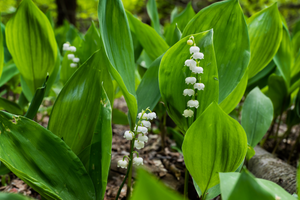 Lily of the Valley is a popular flower in many spring gardens.
Lily of the Valley is a popular flower in many spring gardens.
It grows natively in temperate forests around the world.
While popular in floral arrangements and bouquets, this flower can be poisonous if ingested.
Flowers, stems, and roots are all poisonous if ingested. They can cause stomach ache and nausea, blurry vision, and a slow, irregular heartbeat.
In more extreme cases, the symptoms can include diarrhea and vomiting, seizures, and heart arrhythmia that can lead to death.
If you suspect that someone has ingested Lily of the Valley, you should seek immediate medical attention.
The line between poison and medicine is often thin, and Lily of the Valley isn’t all bad. It can be used medicinally to treat seizures, heart disorders, and burns. During WWI, it was used to treat the effects of gas poisoning.
Related: 5 Poisonous Plants That Can Be Used As Medicine When SHTF
Foxglove
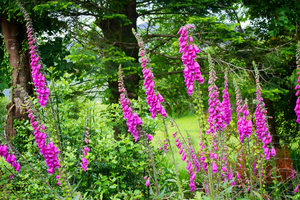 Foxglove is a common garden plant known for its pretty flowers.
Foxglove is a common garden plant known for its pretty flowers.
But don’t let its innocent appearance fool you.
All parts of the plant are poisonous as it contains certain cardiac glycosides, chemicals that can affect heart rate.
As we mentioned with Lily of the Valley, poison, and medicine can be two sides of the same coin.
Foxglove can be a potent heart medicine when used properly. However, if the dosage is incorrect, it can be fatal.
Oleander
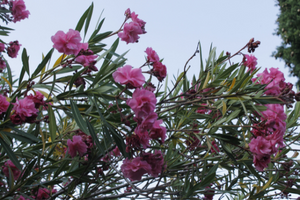 A common flowering shrub in Southern gardens, Oleander is not only beautiful but also highly toxic.
A common flowering shrub in Southern gardens, Oleander is not only beautiful but also highly toxic.
All parts of this plant contain compounds that are poisonous to both humans and animals.
Related: 7 Foraging Mistakes That Might Get You Killed
And you don’t need to eat a lot either. Just a tiny amount can slow or irregular heartbeat, low blood pressure, visual disturbances, vomiting, and diarrhea.
Consuming large amounts can cause death or long-term health problems.
Yew
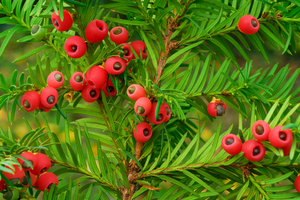 Yews are evergreen shrubs that are commonly found in gardens and used as hedges.
Yews are evergreen shrubs that are commonly found in gardens and used as hedges.
But this ornamental plant, while attractive is highly toxic.
All parts of the plant are poisonous, but it’s the berries that are most concerning.
The small red berries produced by yew are particularly attractive to children. This is concerning as the seeds contain the highest concentrations of toxic compounds.
Also concerning is that the toxicity levels are higher in winter when yew is commonly used as holiday decorations. Certain varieties, like English yew, are more toxic than other varieties.
Pokeweed
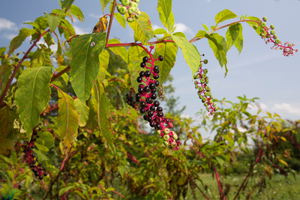 Pokeweed is a common wild plant that grows across much of the US.
Pokeweed is a common wild plant that grows across much of the US.
While commonly found on forest edges, it can also be a garden weed.
The berries look similar to grapes, making them particularly attractive to children.
However, they are highly poisonous, though more so when they are unripe and green.
In fact, the whole plant is poisonous, causing various symptoms, including abdominal distress, difficulty breathing, and death.
Young stems and leaves can be edible if cooked and prepared properly.
Belladonna
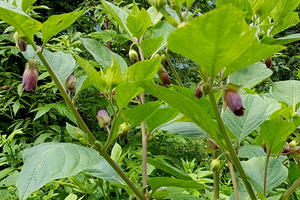
If you don’t know belladonna, you may know it by one of its other common names, deadly nightshade. Despite its toxicity, it has been used by people throughout history for its medicinal properties. Belladonna can grow to 7 feet tall and features oval leaves and purple bell-shaped flowers.
When it fruits, the berries begin green and ripen to a purplish-black, that makes them attractive to animals and children.
Related: How to Tell the Difference Between the Poisonous Virginia Creeper and the Healthy American Ginseng
While the berries are the most come source of accidental belladonna poisoning in children, all parts of the plant are poisonous and hallucinatory.
Castor Bean
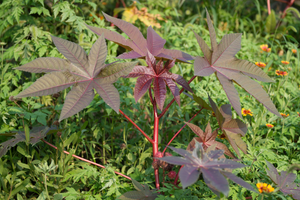 Castor bean plants grow as a weed in the southern area but are often planted as an ornamental in more northern climates.
Castor bean plants grow as a weed in the southern area but are often planted as an ornamental in more northern climates.
The plants feature large star shaped leaves and prickly seed pods making it an attractive and distinct addition to your garden.
However, the seeds contains the deadly poison ricin. Eating as few as four seeds can kill an adult and even fewer will kill a child. However the seeds can be pressed into a non-toxic oil that can be used medicinally.
Water Hemlock
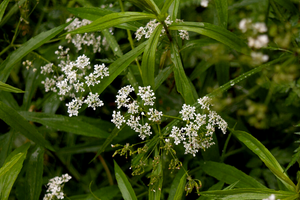 According to the USDA, Water Hemlock is the most poisonous plant growing in America. It contains a toxin called cicutoxin, which causes violent convulsions and death.
According to the USDA, Water Hemlock is the most poisonous plant growing in America. It contains a toxin called cicutoxin, which causes violent convulsions and death.
If you mistake water hemlock for a non-toxic plant, like celery or wild parsnip, it can kill you in as little as 15 minutes.
Not only is water hemlock dangerous to humans, but it is also poisonous to livestock as well.
A wetland plant, it is commonly found along streams and wet meadows in the Western US. It can reach 2 – 3 feet tall, has small white flowers and notched leaves.
Wisteria
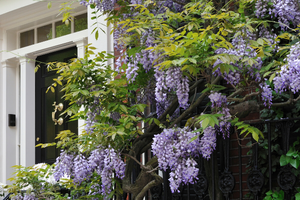 A common ornamental vine, known for its beautiful purple flowers, wisteria is another plant that is highly toxic if ingested.
A common ornamental vine, known for its beautiful purple flowers, wisteria is another plant that is highly toxic if ingested.
While all parts of the plant are poisonous, the most common part to be ingested are the seeds which can be confused for beans.
While wisteria is unlikely to kill you, eating it will make you ill for several days. Symptoms include headache, upset stomach, dizziness, and confusion. They can linger for up to a week.
Manchineel Tree
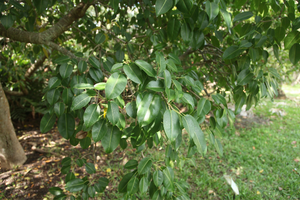 The Manchineel tree is only found in Florida, but it’s still worth mentioning because it is extremely dangerous.
The Manchineel tree is only found in Florida, but it’s still worth mentioning because it is extremely dangerous.
The tree contains a toxic sap that can cause extreme contact dermatitis.
Just standing beneath the tree during a rain storm can lead to blistering.
This deadly tree has a deceptively innocent looking fruit that will taste sweet until the poisonous sap begins to burn your esophagus and stomach.
Related: The Most Dangerous Tree In The U.S.
In places where the trees are common, they are often marked to advise people of the danger.
Rhododendrons and Azaleas
Both rhododendrons and azaleas are common backyard shrubs planted for their beautiful flowers.
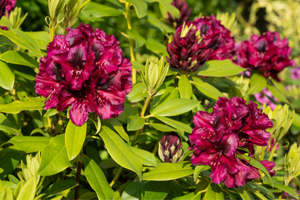
But if you eat large amounts of any part of either plant or even honey made from their flowers, it can cause life-threatening symptoms.
The most common problem associated with these shrubs comes from children trying to suck the nectar from the flowers like they were honeysuckles.
While the symptoms are generally mild, they include mouth irritation, nausea, and vomiting.
More concerning is eating actually honey made by bees with pollen gathered from these flowers. It has been called “mad honey” because of the confusion it can cause. More concerning symptoms are low heart rate and blood pressure, which can cause death.
Interestingly enough, rhododendron honey was used as a bioweapon way back in the first century BC. Roman troops were poisoned by the Turkish by feeding them, contaminated honey. Their subsequent confusion and vomiting contributed to their defeat in battle.
Beekeepers especially shouldn’t keep azaleas or rhododendrons in their gardens.
You may also like:
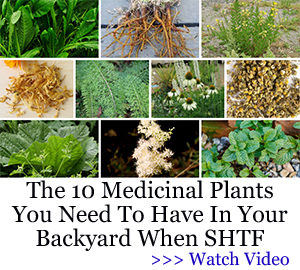 11 Wartime Ration Recipes Every Prepper Should Try
11 Wartime Ration Recipes Every Prepper Should Try
The Tree That Can Actually Get You Killed (Video)
Are You Prepared for the Biggest Social Unrest of Our Modern Times?
How To Deal With Neighbors And Friends That Come Begging For Food At Your Door In A Crisis

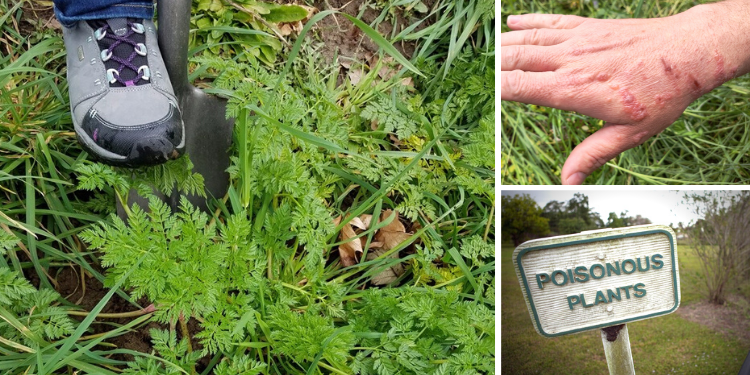













Perhaps having those plants would be a good thing…. Never know when you might need them.
So never have castor bean plants… but wait, it has a medicinal use? Make up your mind!
Yes, properly prepared this is where Castor Oil comes from. Laxative properties and also used for lubricant in some massage oils.
A few comments: One, we always ate pokeweed in the spring as youngsters. Of course I grew up on a farm with very poor sandy soil, so the toxins were probably not concentrated. We just cut the early shoots and my mother boiled them as our first veggies, calling them “Indian asparagus”. We never experienced any problems. The toxicity may be greater in heavy fertile soils.
Second, relating to toxic honey: That of mountain laurel is also toxic (locally called ‘ivy’ in the Appalachians). Plus its leaves (and probably those of rhododendron and azalea) are very toxic to sheep and goats, who will eat them if nothing else is available. Causes staggering and abortion of the young, and death.
(Do not overgraze your pastures…or overload them with more animals than can be sustained in years of drought.)
Another caution: Iris is also toxic, not sure if all of the plant is, or just the roots. In areas where wild iris/blue flag is common in marshy areas, be sure to exercise care when harvesting cattail roots, lotus roots, etc.
I forage many plants–ones I am sure of–but I will never harvest wild celery or anything that remotely resembles poison hemlock since it is often difficult to know the difference in early stages. Also I do not know enough about mushrooms, except morels and large puffballs, to be confident that I am harvesting safe ones or immature poisonous varieties. Some people are experienced and I leave it to them–yet some veteran foragers have made fatal mistakes too.
That is an interesting point you brought up regarding toxicity being related to soil content. That is something to ponder…
Another point you brought up is drought. There are some areas that have had exponential population growth and the water available isn’t enough for everyone. I will be planting a little veggie garden this year but it will have the plants closer together than I have in the past. The plants will shade each other more this way and any watering done will be localized.
Though soil toxicity may be an issue where there is heavy pesticide use, or where the soil has been contaminated by other issues, this is not what causes pokeweed to become poisonous. Pokeweed is safe to eat in spring when the young shoots are still green, but once the stalk begins to streak red then it becomes poisonous.
God gave us the red streaks as a warning.
Lori: Thanks, I didn’t know that about pokeweed.
I know it can take years to cleanse a field of chemicals and a lot of decades to get rid of them in ground water. The state of Delaware, tho farming is pretty much gone, still was advising a few years ago (last I heard of it from family there) to boil water before consuming because of all the chemicals that went into the soil. niio
Another poisonous plant that’s throughout the SW US is Angel Trumpet/Jimsonweed/Datura Wrightii. Like so many other poisonous plants, it has been used medicinally. In this case, by many native tribes.
You probably wouldn’t accidentally eat the plant, and it’s been more of a problem with cattle than with humans, who will eat it if they are out of their normal forage due to drought.
My sisters wild BLM pony ate calla Lilys that were planted around the house. It die
d in a Pretty Horrific manner.
Dupin: It grows wild around this area of Arizona and the only ones consuming it are witches, those who think it’s sacred. Bujos, skinwalkers, shon people and so on. But, an herbalist will use a little (very little) in a mix to stop bleeding. Up at shiprock, the Navajo Nation capital, a skinwalker went insane after eating too much root and tried to kill everyone he saw. It took 16 shots by the cops to stop him. Even that didn’t kill him, not right off. niio
shot placement is everything
Datura is used by many of the native tribes in the SW for spiritual and metaphysical purposes. Dosage appears to be key, as you point out. Too much and you can go on a PCP-style rampage.
That said, I’ve grown it in my gardens on occasion (heavy freezes the last couple of years took my most current attempts out). The white trumpet-like flowers are beautiful. Makes me think I’ll see about getting another one or two to plant this weekend.
Daupin: Show me who is using it for more than a medicine. I live in Arizona and am American Indian, have spent a night in a Mouth of Hell, seen vision, done many a thing, and never used drugs to induce visions because that’s witchcraft, the dark sort, among us. Castaneda lied. He wrote his things for cash on the barrelhead and little of it is true because no one talks to people outside their circle/clan about such things. niio
I’ve had all of them around, except maybe castor bean. I have Water Hemlock which is pretty dangerous because it looks similar to wild garlic. But, it grows later in the summer.
mmmkay. deer are smart enough to not eat any of these. are you dumber than a four legged animal that jumps in front of trucks with headlights on and horn blaring?
A little over five years ago, several elk died from eating yew planted in Sun Valley. Autopsies were done and bits of yew were found in their digestive systems. The area wildlife manager said that the yew is so toxic that it only takes a small amount to kill an elk. Sometimes grazing animals, such as cattle and horses, have been found dead near yew. In past years, pronghorn, moose and deer have died in Idaho after eating just a handful of yew leaves.
Interestingly, birds eat the fleshy covering of the yew seeds, as that isn’t toxic.
“several elk” what like three of them? three winters ago in Oregon an entire elk herd tried to cross a frozen river and the ice broke and the entire herd died. Eff the yew plant and your “several” animals. What did they do before we were here? did the indians run around picking all poisonous plants because they were afraid animals would eat them?
And a lot of the plants listed in this article are awesome landscaping plants and they are all over properties here. By some grace of god our kids don’t run out and eat Rhodies and Azaleas. Crazy right? It might be hard to comprehend. But most kids don’t eat random plants in the yard.
The Headlights blind them,that’s why they just stand there looking at you…
Yeah, I’ll stick with meat and taters, thanks.
this is why I bought a book with both descriptions and photo’s of edible plants to forage, and also lists plants to avoid.
It’s obvious the author of this article doesn’t have any experience with live stock or they would have included False Hellebore.
White snakeroot, buttercup, dogbane, english ivy…..
Even the leaves of tomatoes.
I’m sure the author left out quite a bit of information, they ALL do. The fact that they post articles, mostly just to share knowledge, is basically a conversation starter. I doubt they’re offended when we add knowledge and experience to the conversation, but posting the negativity is only good for trashing up the content and spreading hate. I’m sure we all enjoy the frequent comic relief, but I for one appreciate and read these articles for knowledge.
Hi, Interesting article. It would be very helpful if you would give the latin name as well as the common name for any plants. Your pokeweed looks like our Japanese knotweed and I eat the spring shoots – they taste like asparagus with an apple tartness, also the leaves can be cooked as a veggie and, most important, the root is used in Stephen Harrod Buhner’s protocols for both Lymes disease and Sars cov-2. http://www.naturalmedicinalherbs.net/herbs/p/polygonum-japonicum=japanese-knotweed.php
Researching pokeweed though it looks like knotweed it’s not! http://naturalmedicinalherbs.net/herbs/p/phytolacca-americana=pokeweed.php and yes, sounds like old leaves are toxic, it too has medicinal uses including research on immune support and AIDS.
In short, you put such great info on this website, resist the temptation of going fear porn on plants!
Good article, thank you. niio
I’ve grown some of these plants and my neighbors grow them. There are many poisonous plants that grow wild and often come up in the garden with the other weeds. NEVER eat any plant you do not know for sure is safe, I was taught this as a young child. When in doubt, walk away,
Mostly these are ornamental plants and shrubs. Of course, don’t eat any, but I wouldn’t go so far as not having them in my yard. Their beauty is amazing. There are a couple, of plants I wouldn’t have, and where I live they pop up on occasion. Those plants are Water Hemlock and of course, Belladonna.
Never ingest anything till you read up on it.